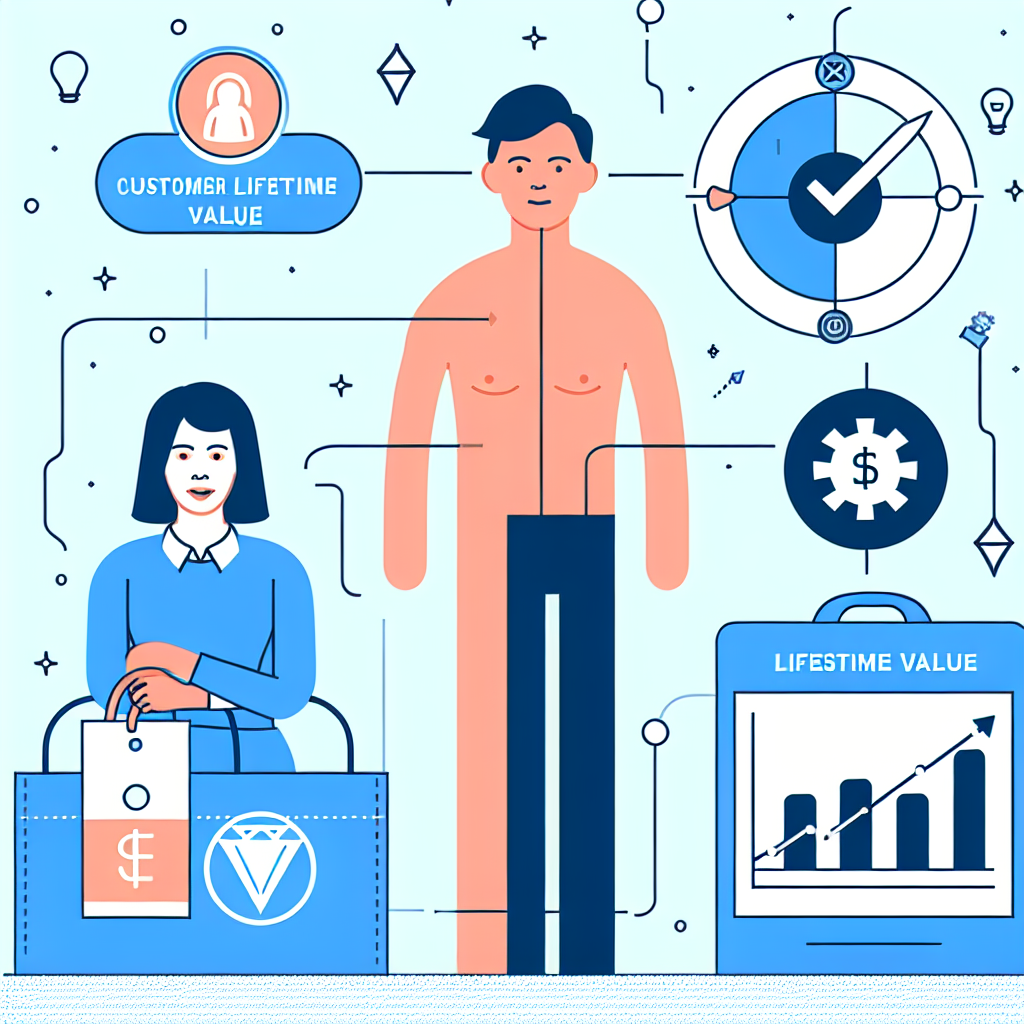-
Table of Contents
- The Importance of Customer Lifetime Value in Business Growth
- How to Calculate and Interpret Customer Lifetime Value
- Strategies for Increasing Customer Lifetime Value
- Case Studies: Successful Implementation of Customer Lifetime Value
- The Role of Customer Lifetime Value in Marketing and Sales Strategies
- Q&A
The Importance of Customer Lifetime Value in Business Growth
Understanding Customer Lifetime Value: A Key Metric for Business Success
In the world of business, success is often measured by various metrics. From revenue growth to market share, these metrics provide valuable insights into the health and performance of a company. One such metric that has gained significant importance in recent years is Customer Lifetime Value (CLV). CLV is a key indicator of a company’s ability to generate long-term value from its customer base. It is a metric that every business should understand and leverage to drive growth and profitability.
So, what exactly is Customer Lifetime Value? In simple terms, CLV is the total value a customer brings to a business over the course of their relationship. It takes into account not only the initial purchase but also the potential for repeat purchases and the customer’s likelihood to refer others to the business. By understanding CLV, businesses can make informed decisions about how much they should invest in acquiring and retaining customers.
The importance of CLV in business growth cannot be overstated. By focusing on maximizing CLV, companies can shift their attention from short-term gains to long-term profitability. This shift in mindset is crucial in today’s competitive landscape, where customer loyalty is increasingly hard to come by. By understanding the lifetime value of their customers, businesses can tailor their marketing strategies and customer experiences to build lasting relationships.
One of the key benefits of understanding CLV is the ability to allocate resources effectively. By identifying high-value customers, businesses can prioritize their marketing efforts and allocate resources where they will have the greatest impact. This targeted approach allows companies to optimize their marketing spend and increase their return on investment. By focusing on customers with a high CLV, businesses can also identify opportunities for upselling and cross-selling, further increasing their revenue potential.
Furthermore, CLV provides valuable insights into customer behavior and preferences. By analyzing the purchasing patterns of high-value customers, businesses can identify trends and preferences that can inform product development and marketing strategies. This customer-centric approach allows companies to stay ahead of the competition by delivering products and experiences that resonate with their target audience.
Another important aspect of CLV is its impact on customer retention. By understanding the lifetime value of their customers, businesses can develop strategies to increase customer loyalty and reduce churn. By investing in customer satisfaction and loyalty programs, companies can create a positive customer experience that encourages repeat purchases and referrals. This not only increases CLV but also reduces the cost of acquiring new customers, leading to improved profitability.
In conclusion, Customer Lifetime Value is a key metric for business success. By understanding the total value a customer brings over their lifetime, businesses can make informed decisions about resource allocation, marketing strategies, and customer retention efforts. CLV allows companies to shift their focus from short-term gains to long-term profitability, ultimately driving growth and success. In today’s competitive landscape, where customer loyalty is paramount, understanding and leveraging CLV is essential for businesses looking to thrive. So, take the time to analyze your customer data, identify your high-value customers, and develop strategies to maximize their lifetime value. Your bottom line will thank you.
How to Calculate and Interpret Customer Lifetime Value
Understanding Customer Lifetime Value: A Key Metric for Business Success
Customer Lifetime Value (CLV) is a crucial metric that businesses must understand and utilize to achieve long-term success. It provides valuable insights into the profitability of individual customers over their entire relationship with a company. By calculating and interpreting CLV, businesses can make informed decisions regarding customer acquisition, retention, and overall marketing strategies.
To calculate CLV, businesses need to consider several key factors. First and foremost, they must determine the average purchase value, which is the average amount a customer spends on each transaction. This can be obtained by dividing the total revenue generated from all transactions by the number of customers. Additionally, businesses need to determine the purchase frequency, which is the average number of transactions a customer makes within a given time period.
Another crucial factor in calculating CLV is the customer lifespan, which refers to the length of time a customer remains active and engaged with a company. This can be determined by analyzing historical data and identifying the average duration of customer relationships. Finally, the gross margin, which is the difference between revenue and the cost of goods sold, must be considered to accurately calculate CLV.
Once these factors are determined, the formula for calculating CLV is relatively straightforward. By multiplying the average purchase value, purchase frequency, and customer lifespan, and then subtracting the acquisition cost, businesses can obtain the CLV. The acquisition cost includes all expenses associated with acquiring and onboarding a new customer, such as marketing and sales costs.
Interpreting CLV is equally important as calculating it. A high CLV indicates that a customer is highly valuable to the business, as they generate significant revenue over their lifetime. On the other hand, a low CLV suggests that a customer may not be as profitable and may require additional efforts to increase their value. By segmenting customers based on their CLV, businesses can identify their most valuable customers and tailor their marketing strategies accordingly.
Understanding CLV also allows businesses to make informed decisions regarding customer acquisition and retention. By comparing the CLV of different customer segments, businesses can identify which segments are most profitable and focus their resources on acquiring similar customers. Additionally, by identifying customers with a high CLV, businesses can implement strategies to increase customer loyalty and retention, ultimately maximizing their long-term profitability.
Furthermore, CLV can guide businesses in setting realistic marketing budgets. By knowing the potential revenue generated by each customer, businesses can allocate their marketing resources more effectively. For example, if the CLV of a customer is significantly higher than the cost of acquiring them, businesses can justify investing more in marketing efforts to acquire similar customers.
In conclusion, understanding and utilizing Customer Lifetime Value is essential for business success. By calculating and interpreting CLV, businesses can gain valuable insights into the profitability of individual customers and make informed decisions regarding customer acquisition, retention, and marketing strategies. CLV allows businesses to identify their most valuable customers, tailor their marketing efforts, and allocate resources effectively. By harnessing the power of CLV, businesses can maximize their long-term profitability and achieve sustainable growth.
Strategies for Increasing Customer Lifetime Value

Strategies for Increasing Customer Lifetime Value
In today’s competitive business landscape, understanding and maximizing customer lifetime value (CLV) is crucial for long-term success. CLV is a key metric that measures the total value a customer brings to a business over their entire relationship. By focusing on strategies to increase CLV, businesses can not only boost their revenue but also build stronger customer relationships and enhance brand loyalty.
One effective strategy for increasing CLV is to provide exceptional customer service. When customers feel valued and well taken care of, they are more likely to continue doing business with a company. This can be achieved by training employees to be attentive, responsive, and knowledgeable, and by implementing systems that allow for quick and efficient problem resolution. By investing in customer service, businesses can create positive experiences that encourage repeat purchases and long-term loyalty.
Another strategy is to personalize the customer experience. Today’s consumers expect tailored interactions and offerings that cater to their specific needs and preferences. By leveraging customer data and implementing advanced analytics, businesses can gain insights into individual customer behaviors and preferences. This allows them to deliver personalized recommendations, offers, and communications that resonate with customers on a deeper level. Personalization not only increases the likelihood of repeat purchases but also enhances customer satisfaction and loyalty.
Furthermore, businesses can increase CLV by implementing effective customer retention programs. These programs aim to engage and retain existing customers by offering incentives, rewards, and exclusive benefits. By providing ongoing value to loyal customers, businesses can foster a sense of belonging and exclusivity, which encourages them to continue their relationship with the brand. Retention programs can include loyalty programs, VIP clubs, and personalized offers based on past purchase history. By investing in customer retention, businesses can reduce churn rates and increase CLV.
Additionally, businesses can leverage cross-selling and upselling techniques to increase CLV. Cross-selling involves offering complementary products or services to customers based on their previous purchases. For example, a customer who has purchased a laptop may be interested in accessories such as a mouse or a laptop bag. Upselling, on the other hand, involves encouraging customers to upgrade to a higher-priced product or service. By effectively implementing cross-selling and upselling strategies, businesses can increase the average order value and maximize the revenue generated from each customer.
Lastly, businesses can increase CLV by focusing on customer satisfaction and loyalty. Satisfied customers are more likely to become repeat customers and advocates for a brand. By regularly measuring customer satisfaction through surveys and feedback, businesses can identify areas for improvement and take proactive steps to address any issues. Additionally, by actively engaging with customers through social media, email marketing, and other channels, businesses can foster a sense of community and loyalty. Happy and loyal customers not only continue to purchase from a brand but also refer it to their friends and family, thereby increasing CLV.
In conclusion, increasing customer lifetime value is essential for business success. By implementing strategies such as providing exceptional customer service, personalizing the customer experience, implementing customer retention programs, leveraging cross-selling and upselling techniques, and focusing on customer satisfaction and loyalty, businesses can maximize the value they derive from each customer. By investing in CLV, businesses can not only increase their revenue but also build stronger customer relationships and enhance brand loyalty, ultimately leading to long-term success.
Case Studies: Successful Implementation of Customer Lifetime Value
Customer Lifetime Value (CLV) is a crucial metric that businesses must understand and utilize to achieve long-term success. By calculating the value a customer brings to a company over their entire relationship, businesses can make informed decisions about marketing strategies, customer retention efforts, and overall business growth. In this section, we will explore some case studies that demonstrate successful implementation of CLV in various industries.
One notable case study is Amazon, the e-commerce giant that has revolutionized the way people shop online. Amazon has long recognized the importance of CLV and has built its business model around maximizing customer lifetime value. By offering a wide range of products, personalized recommendations, and a seamless shopping experience, Amazon has successfully retained customers and increased their CLV. Additionally, Amazon’s Prime membership program, which offers free shipping and exclusive benefits, has further incentivized customers to remain loyal, resulting in higher CLV.
Another example of successful CLV implementation is Starbucks, the renowned coffee chain. Starbucks understands that customer loyalty is crucial in the highly competitive coffee industry. By focusing on creating a unique and personalized customer experience, Starbucks has managed to increase customer retention and CLV. Through their rewards program, customers earn points for every purchase, which can be redeemed for free drinks and other perks. This strategy not only encourages repeat business but also fosters a sense of loyalty and belonging among customers, leading to higher CLV.
In the telecommunications industry, T-Mobile has emerged as a leader in leveraging CLV to drive business growth. T-Mobile recognized that customer churn, or the rate at which customers switch to competitors, was a significant challenge. To combat this, T-Mobile introduced its “Un-carrier” strategy, which aimed to disrupt the industry by offering transparent pricing, unlimited data plans, and innovative customer benefits. By focusing on customer satisfaction and retention, T-Mobile has successfully reduced churn and increased CLV. This strategy has not only helped T-Mobile gain market share but also positioned the company as a customer-centric brand.
The automotive industry has also embraced CLV as a key metric for success. Tesla, the electric car manufacturer, has revolutionized the industry by prioritizing customer experience and long-term relationships. Tesla’s direct-to-consumer sales model allows them to gather valuable customer data, enabling them to personalize their offerings and provide exceptional customer service. By focusing on customer satisfaction and loyalty, Tesla has managed to create a strong brand following and increase CLV. Additionally, Tesla’s continuous innovation and commitment to sustainability have further enhanced their customer relationships, resulting in higher CLV.
These case studies highlight the importance of understanding and implementing CLV in various industries. By focusing on customer retention, loyalty, and satisfaction, businesses can increase their CLV and achieve long-term success. It is crucial for businesses to invest in strategies that prioritize customer experience, personalized offerings, and innovative benefits. By doing so, businesses can build strong customer relationships, reduce churn, and ultimately increase their bottom line. Customer Lifetime Value is not just a metric; it is a key driver of business success in today’s competitive landscape.
The Role of Customer Lifetime Value in Marketing and Sales Strategies
Understanding Customer Lifetime Value: A Key Metric for Business Success
In today’s competitive business landscape, companies are constantly seeking ways to gain a competitive edge and drive growth. One key metric that has emerged as a crucial factor in achieving business success is customer lifetime value (CLV). CLV is a metric that measures the total value a customer brings to a business over the course of their relationship. It takes into account not only the initial purchase but also the potential for future purchases and the overall loyalty of the customer.
The role of customer lifetime value in marketing and sales strategies cannot be overstated. By understanding the value that each customer brings to the business, companies can make more informed decisions about how to allocate their resources and tailor their marketing efforts. This allows them to focus on acquiring and retaining high-value customers, rather than wasting time and money on customers who are unlikely to generate significant long-term value.
One of the key benefits of using CLV as a metric is that it provides a more accurate picture of a customer’s value than traditional metrics such as average order value or customer acquisition cost. While these metrics can be useful in certain contexts, they fail to capture the full extent of a customer’s value over time. CLV, on the other hand, takes into account not only the initial purchase but also the potential for repeat purchases and the likelihood of the customer referring others to the business.
By understanding the lifetime value of their customers, businesses can make more informed decisions about how much they are willing to spend to acquire new customers. For example, if a company knows that the average customer will generate $500 in profit over their lifetime, they can make more informed decisions about how much they are willing to spend on marketing and advertising to acquire new customers. This allows them to allocate their resources more effectively and maximize their return on investment.
Furthermore, CLV can also help businesses identify opportunities for upselling and cross-selling. By understanding the potential value of each customer, companies can tailor their sales strategies to encourage customers to make additional purchases or upgrade to higher-value products or services. This not only increases the immediate revenue generated from each customer but also increases the likelihood of repeat purchases and long-term loyalty.
In addition to its role in marketing and sales strategies, CLV can also be a valuable tool for customer segmentation and targeting. By segmenting customers based on their lifetime value, businesses can identify their most valuable customers and tailor their marketing efforts to meet their specific needs and preferences. This allows companies to build stronger relationships with their most valuable customers and increase their overall satisfaction and loyalty.
In conclusion, customer lifetime value is a key metric for business success. By understanding the value that each customer brings to the business over the course of their relationship, companies can make more informed decisions about how to allocate their resources, tailor their marketing efforts, and maximize their return on investment. CLV provides a more accurate picture of a customer’s value than traditional metrics and can help businesses identify opportunities for upselling, cross-selling, and customer segmentation. In today’s competitive business landscape, understanding and leveraging CLV is essential for companies looking to gain a competitive edge and drive growth.
Q&A
1. What is customer lifetime value (CLV)?
Customer lifetime value (CLV) is a metric that calculates the total revenue a business can expect to generate from a customer throughout their entire relationship with the company.
2. Why is CLV important for businesses?
CLV is important for businesses because it helps them understand the long-term value of their customers. By knowing how much revenue a customer is likely to generate over time, businesses can make informed decisions about marketing, customer acquisition, and retention strategies.
3. How is CLV calculated?
CLV is typically calculated by multiplying the average purchase value by the average purchase frequency and then multiplying that by the average customer lifespan. This formula provides an estimate of the total revenue a business can expect from a customer.
4. What are the benefits of understanding CLV?
Understanding CLV allows businesses to allocate their resources more effectively. It helps them identify their most valuable customers, tailor marketing efforts to specific customer segments, and make strategic decisions about customer acquisition and retention.
5. How can businesses improve their CLV?
Businesses can improve their CLV by focusing on customer satisfaction and loyalty. Providing excellent customer service, personalized experiences, and building strong relationships with customers can increase their lifetime value. Additionally, businesses can implement strategies to encourage repeat purchases and upselling to increase the average purchase value and frequency.








